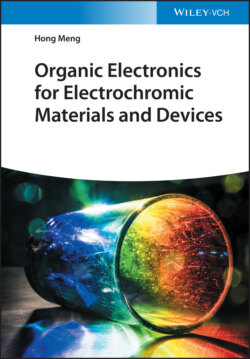Читать книгу Organic Electronics for Electrochromic Materials and Devices - Hong Meng - Страница 2
Table of Contents
Оглавление1 Cover
2 Title Page
3 Copyright
4 Preface
5 About the Author
6 1 Introduction 1.1 General Introduction 1.2 The History of Electrochromic Materials 1.3 The Key Parameters of Electrochromism 1.4 Conclusion References
7 2 Advances in Polymer Electrolytes for Electrochromic Applications 2.1 Introduction 2.2 Requirements of Polymer Electrolytes in Electrochromic Applications 2.3 Types of Polymer Electrolytes 2.4 Conclusion and Future Outlook References
8 3 Electrochromic Small Molecules 3.1 Background of Small Molecule Electrochromic 3.2 Technology Development of Small Molecule Electrochromic Materials 3.3 Violene–Cyanine Hybrids (AIE PL OEC) 3.4 Terephthalate Derivatives (Multicolor OEC) 3.5 Isophthalate Derivatives 3.6 Methyl Ketone Derivatives 3.7 Diphenylacetylenes 3.8 Fluoran Dye Derivatives 3.9 PH‐Responsive Molecule Derivatives 3.10 TPA Dye Derivatives 3.11 Hydrocarbon Derivatives‐NIR‐OEC 3.12 Conclusions and Perspective References
9 4 Viologen OEC 4.1 The Introduction of OEC and Viologen 4.2 Different Structures of Viologen‐Based Electrochromic Materials 4.3 Viologen Electrochromic Device 4.4 Companies Operating in the Field of Viologen Electrochromism 4.5 Conclusion References
10 5 Metallohexacyanates 5.1 Background 5.2 Technology Development of PB 5.3 Crystal Structure 5.4 Electrochromic Mechanism 5.5 Synthesis 5.6 Electrochromic Devices (ECDs) 5.7 Nanocomposites 5.8 PB Analogs 5.9 Multifunctional Applications References
11 6 Electrochromic Conjugated Polymers (ECPs) 6.1 Introduction 6.2 Thiophene‐Based Conjugated Electrochromic Polymers 6.3 Polypyrroles‐Based Conjugated Electrochromic Polymers 6.4 Polycarbazole‐Based Conjugated Electrochromic Polymers References
12 7 TA‐Based Electrochromic Polyimides and Polyamides 7.1 Introduction 7.2 Development of TA‐Based Electrochromic Polyimides and Polyamides 7.3 Conclusions References
13 8 Metallo‐Supermolecular Polymers 8.1 Introduction 8.2 Single Metallic System 8.3 Hetero‐Metallic System 8.4 The Fabrication Method of Metallopolymer Film 8.5 Conclusion References
14 9 Metal‐Organic Framework (MOF)‐ and Covalent Organic Framework (COF)‐Based Electrochromism (EC) 9.1 Introduction 9.2 Current Studies in EC MOFs 9.3 Current Studies in EC COFs 9.4 Conclusion and Prospect References
15 10 Nanostructure‐Based Electrochromism 10.1 Introduction 10.2 Current Studies of Nanostructure in Electrochromism 10.3 Conclusion and Prospect References
16 11 Organic Electroluminochromic Materials 11.1 Introduction 11.2 Conventional Mechanisms of Electroluminochromism 11.3 Electroluminochromic Performance Parameters 11.4 Classical Materials 11.5 Future Perspectives and Conclusion References
17 12 Organic Photoelectrochromic Devices 12.1 Introduction 12.2 Structure Design of PECDs 12.3 Future Perspectives and Conclusion References
18 13 Application of OEC Devices 13.1 Smart Window 13.2 Dimmable Rearview Mirror 13.3 Sensors 13.4 The Application of Electrochromic Device in Display 13.5 Other Applications of OEC References
19 14 Commercialized OEC Materials and Related Analysis of Company Patents 14.1 General Introduction 14.2 Gentex Corporation 14.3 Ricoh Company, Ltd. 14.4 Canon Inc. 14.5 BOE Technology Group Co., Ltd. and OPPO Guangdong Mobile Communications Co., Ltd. 14.6 Other Important Enterprises 14.7 Conclusion References
20 15 Main Challenges for the Commercialization of OEC 15.1 Introduction 15.2 The Long‐Term Stability of OEC Materials 15.3 The Mechanical Stability of OEC Devices (Encapsulation Technology) 15.4 Large‐Area Process Technology: Spray Coating and Roll‐to‐Roll Processes 15.5 Conclusions and Perspective References
21 Index
22 End User License Agreement
